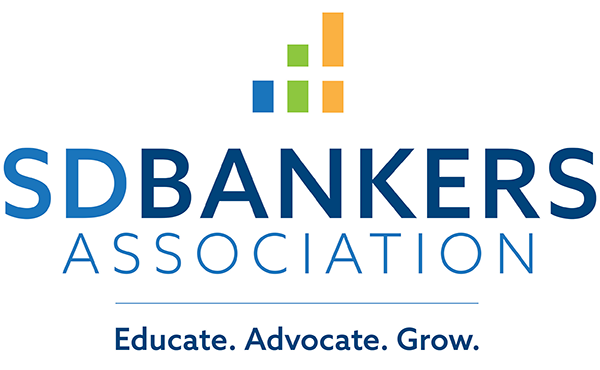- Education & Events
- Advocacy
- Products & Services
- Membership
- Resources
- SDBANKER Magazine
- SDBA eNews
- SDBA eNews Archives
- Legislative Update/Bill Watch
- South Dakota Bank Directory
- Women in Banking
- Scenes of South Dakota Calendar*
- Holiday Signs
- Regulatory Report
- South Dakota Banking Code
- Record Retention Manual
- Advertising & Sponsorship Guide
- COVID-19 Resources
- Mental Health and Crisis Prevention
- About
|
[Free Webinar!] 5 Common Mistakes in Onboarding for Financial Institutions - Friday, November 17
Ag Lender Survey: Liquidity, Farm Income Top Ag Lender Concerns for Producers in 2023Liquidity has become the primary concern among agricultural lenders for their producer customers followed closely by farm income levels, according to the 2023 Agricultural Lender Survey report produced jointly by the American Bankers Association and the Federal Agricultural Mortgage Corporation, more commonly known as Farmer Mac (NYSE: AGM and AGM.A). Rising input costs, previously ranked as the top concern in 2021 and 2022, dropped to the third highest this year, according to the report released today at the ABA Agricultural Bankers Conference in Oklahoma City. “After a record-setting year of farm income, producers have experienced some margin compression in 2023 and lenders are taking notice,” said Jackson Takach, Farmer Mac’s chief economist. “During economic cycle transitions, the fundamentals are increasingly important, and I think that’s why you see lenders rank balance sheet liquidity and farm income levels as their top concerns facing producers in the coming year.” “Despite margin compression, agricultural credit quality remained strong in 2023,” said Tyler Mondres, senior director of research at ABA. “Lenders expect a return to trend for credit quality in the coming year, which was reflected in a moderate increase in concern for ag loan deterioration. While lenders are taking prudent risk management steps in response, such as reviewing underwriting standards and loan terms, they are prepared to continue providing critical support to America’s farmers and ranchers.” The annual survey—now in its eighth year—provides insight from agricultural lenders to gauge overall industry sentiment on the farm economy, expectations on land values, prospects for the coming year and issues facing the broader economy. Responses represent a range of institutions by size—from less than $50 million in assets to more than $1 billion—and by geography. Key findings from this year’s survey report include: Top Lender Concerns for ProducersLiquidity and farm income returned to the top of the list of lender concerns for producers. Concerns about other inflationary pressures (rising interest costs), the No. 1 concern in 2022, fell to the third greatest overall concern for producers in 2023. Recession risk remained a middling concern for lenders despite worries about an economic slowdown over the coming year. Top Overall Concerns for LendersThe various impacts of a rising interest rate environment were a common theme in the 2023 survey. Accordingly, interest rate volatility remained the No. 1 perceived concern facing lending institutions in 2023. Lender competition along with credit quality were the second and third greatest overall concerns, respectively. “After the Fed hiked rates 425 basis points in 2022 and an additional 100 basis points in 2023, it is no surprise that interest rate volatility remained the No. 1 concern facing ag lenders’ institutions,” Mondres said. “While elevated rates have not depressed loan demand, it drove deposit costs to a decade-long high for ag banks in the second quarter of 2023.” Sector ConcernsRespondents' level of concern for dairy and swine increased in 2023. More than half of respondents ranked their level of concern for dairy a four out of five or higher and nearly a quarter expressed similar concern for swine, up from 28% and 15%, respectively, in 2022. In comparison, concern levels declined by a notable amount for fruits and nuts and beef cattle. Profitability ExpectationsAg lenders estimate that more than three-quarters of their borrowers will remain profitable in 2023 and two-thirds will remain profitable through 2024. However, there was greater dispersion in responses regarding the level of overall farm profitability. Only 28% of lenders reported an increase in borrower profit margins, down from 66% last year. Lenders expect farm income compression over the next 12 months, with 70% projecting a decline in farm profitability. Land Value and Cash Rent ExpectationsFarmland values continued their upward march in 2023. Lenders’ perceptions of farmland values showed an increase of 11% in 2023, with some variation across regions. However, several tailwinds have turned to headwinds as incomes have declined and interest rates have increased. As a result, most lenders expect land values will remain stable over the next year. Cash rents, meanwhile, have been slower to increase and could rise further in 2024. Credit QualitySurvey respondents across all regions reported lower ag loan delinquencies and charge-off rates in 2023. However, lenders expect credit quality to deteriorate in the coming 12 months, reverting to historic levels. Consistent with this expectation, more than two-fifths of respondents reported tightening underwriting standards and loan terms in 2023 (up from 30% and 22%, respectively, in 2022). Loan DemandAg lenders reported an increase in demand for both loans secured by farmland and agricultural production loans increased in 2023. Respondents anticipate that loan demand for both categories will continue to increase over the next 12 months. Approval RateLenders reported an average agricultural loan application approval rate for new loans of 86% in the 12 months leading up to August 2023 and expect the approval rate for renewal requests to be 89% in the following 12 months. About the SurveyThe annual ABA and Farmer Mac Agricultural Lender Survey report is a joint effort to provide a look at the agricultural economy and market forces from the unique perspective of ag lenders. More than 260 agricultural lenders completed the survey between Aug. 1 and Sept. 1, 2023. The responses came from a diverse set of institutions, ranging from those with under $50 million in assets to those with more than $1 billion in assets. Regionally, the responses were somewhat concentrated in the Corn Belt and Plains. ABA and Farmer Mac have been working together for more than a decade to offer the financial and educational tools bankers need to serve their agricultural customers. To view the full Agricultural Lender Survey Report, please visit aba.com/agsurvey. FHFA Issues Federal Home Loan Bank ReportThe Federal Housing Finance Agency today issued its long-expected report on the comprehensive review of the Federal Home Loan Banks, culminating a process that began last year in conjunction with the 100th anniversary of the FHLB system. Among other things, the agency said it will update the mission statement of the system to reflect the primary goals of providing stable liquidity to FHLB members and supporting housing and community development. Regarding FHLB membership, the agency noted that authority lies with Congress, but if lawmakers decide to allow entities currently not allowed under existing law—such as nonbank mortgage companies—they should be held to the same requirements as most current members. At the same time, the FHFA said that it will consider harmonizing the manner in which membership eligibility requirements are applied to the different membership types. Of particular concern to the American Bankers Association, FHFA indicated that it will propose a rule to impose an ongoing 10% mortgage asset test on “some members.” This would be a significant and costly change to the existing borrowing structure that has served the system well, according to the association. The report recommends several steps to better position FHLBs to perform their liquidity mission. They include enhancing the ability of FHLBs to maintain interest-bearing deposits with commercial banks to manage intra-day liquidity requests, as well as limiting the potential for an increase in debt issuance costs for all members following a large liquidity request from a single member. The FHFA also said it will expand FHLBs’ housing and community development focus by, among other things, requiring FHLBs to establish mission-oriented collateral programs and improve their engagement with mission-oriented members, such as community development financial institutions. The report also indicates that FHFA will develop improved metrics and thresholds to oversee FHLBs and will incorporate mission performance in the supervisory rating and evaluation processes. Finally, the report includes recommendations for changes that can only be made by Congress. Among them is a proposed doubling of the statutory minimum for the FHLBs’ affordable housing programs. The agency is recommending that lawmakers amend the Bank Act to authorize all CDFI and credit union members with assets below the statutory cap to pledge community financial institution collateral to secure FHLB advances. It also recommends that Congress provide more flexibility on who can serve on FHLB boards. Nichols: Report showcases essential role of FHLB systemABA commends the FHFA for recognizing the essential role of the FHLB system, which is a valuable partner for banks of all sizes in meeting the needs of their communities, ABA President and CEO Rob Nichols said. Nichols added that while ABA is still reviewing the report, the document makes clear that the agency understands the system’s important dual mission to serve as both a source of liquidity for member banks and as an avenue for members to advance affordable housing and community development. “The report also notes that the FHFA plans further rulemaking and other actions, some of which raise concern,” Nichols said. “We look forward to discussing the report and its recommendations with the FHFA, member banks and other stakeholders to ensure the Federal Home Loan Bank System will continue to play its important role going forward.” ABA’s Nichols: Educating Lawmakers on Issues like ACRE and Capital Rules Takes TeamworkPolitical advocacy in Washington, D.C., is a team sport that extends well beyond Capitol Hill, American Bankers Association President and CEO Rob Nichols told a gathering in Oklahoma City today for the association’s 71st Agricultural Bankers Conference. Working with state banking associations is just part of that teamwork, Nichols said. “There’s so much impacting our sector right now—from a legislative, regulatory and reputational standpoints,” he explained. “It really is important for you to be engaged. Policymakers are very attentive to bankers from their home state.” A good example of the need for and success of such teamwork has been with the Access to Credit for our Rural Economy Act—or ACRE—which was introduced earlier this year in the House and Senate. ACRE would give community banks the same tax-exempt status on certain earned interest that applies to Farm Credit institutions, allowing farm real estate borrowers and rural homeowners access to lower interest rates. The exemption would also apply to single-family home mortgage loans in small rural communities and for mortgages less than $750,000. There currently are 45 cosponsors in the House, including 13 Democrats, which is the most Democratic support the legislation has had. But there remains “some work to do,” said ABA EVP Kirsten Sutton, who joined Nichols for the policy discussion. “We need to advocate for this legislation in a way that puts consumers first and highlights our ag members’ desire to bring much-needed resources to these communities,” she said. Nichols and Sutton urged ag bankers to contact their elected officials—particularly in Democratic areas—and ask them to sign on to ACRE, in addition to asking any of the agricultural associations they belong to, to endorse the legislation so that lawmakers can hear from end-user beneficiaries. During his remarks, Nichols also explained why ag bankers should care about the Federal Reserve’s so-called “Basel III endgame” proposal. ABA has raised concerns that the proposal would impose unnecessary new capital requirements, limiting credit availability and threatening economic growth and resiliency. As regulators have repeatedly affirmed and recent stress tests have demonstrated, the U.S. banking system is already well capitalized, and regulators have not demonstrated how the proposal would increase safety and soundness, he said. “This was crafted in 2017 before COVID, before the interest rate environment change, before the spring bank failures,” Nichols explained, adding that the landscape is “totally different” today and that it would have “a very direct effect” on the ag sector. “If you care about capital access, you should care about this rule.” He added that the rule would contribute to the unlevel playing field between banks and the Farm Credit System, curtail some of the derivative transactions the ag sector uses and suppress ag lending. ABA: CRA Rule Will Change How Banks Do BusinessThe proposed interagency Community Reinvestment Act modernization rule is unnecessarily complex, overly prescriptive and would result in a significantly greater regulatory burden for all banks, especially community banks, Federal Reserve Governor Michelle Bowman said today. Bowman was the only member of the Fed board to vote against moving forward with the CRA final rule last month. Speaking at an Ohio Bankers League conference, she spelled out her concerns with the rule, saying its positives are outweighed by its negatives. “First and foremost, the final rule applies the same regulatory expectations for small banks as it does for the largest banks,” Bowman said. “For example, a wide range of community banks—those with more than $2 billion in assets—are treated as ‘large banks’ under the final rule, forcing these banks to comply with the same CRA evaluation standards as a bank with $2 trillion in assets.” She also said that the rule exceeds the authority granted by Congress, particularly provisions to evaluate banks outside of their deposit-taking footprint. “Perhaps most concerning about the final rule is that it may incentivize banks to reduce their support for certain communities, forcing them to pare back lending in areas where there is a need for credit accessibility,” she said. Bowman also shared her concerns about a Fed proposal to lower the regulatory cap on debit card interchange fees. “While the board’s proposed rule suggests that it could result in benefits to consumers, I am concerned that the costs of this fee cap revision for consumers—through the form of increased costs for banking products and services—will be real, while the benefits to consumers—such as lower prices at merchants—may not be realized,” she said.
GSB Scholarships Available for 2024The Graduate School of Banking is pleased to offer a variety of scholarships to assist bankers in advancing their educations and careers. Some applications are available directly from their website; other scholarship applications are through our association partners. Applications for Graduate School of Banking scholarships must by submitted no later than March 1st; Human Resource Management School scholarship applications are due by February 1st. Outstanding Leader ScholarshipThis at-large scholarship is awarded directly from the Prochnow Educational Foundation. Bankers from any state or country entering their first year at GSB are eligible to apply. Two scholarships are awarded annually, and selection is based on leadership experience and potential as well as banking industry involvement. This scholarship pays $1,500 per session toward GSB tuition for each of three GSB resident sessions, totaling $4,500. Ann Kleist Scholarship (Community Service)Ann Kleist, former GSB vice president and CFO, retired in 2012 after 37 years of service to GSB. This scholarship honors not only Ann’s contributions to the school, but her dedication to community service and volunteerism. The banker selected for this award will not only be active in banking, but also engaged in giving back to their community through volunteerism. This scholarship pays $1,500 per session toward GSB tuition for each of three GSB resident sessions, totaling $4,500. Applicants must be entering their first year at GSB. AMBA Andy Trovillion Scholarship (Military Service)Raleigh A. “Andy” Trovillion, former GSB faculty member and Association of Military Banks of America (AMBA) board chairman, passed away in 2019 after a distinguished career in banking. This scholarship, which is funded by the AMBA, honors Andy’s passions for and contributions to military banking and banking education. Bankers eligible for this scholarship must be serving or have served honorably as an active duty, Reserve, or National Guard member of one of the Armed Services of the United States. Bankers who are military spouses or spouses of veterans are also eligible to apply. This scholarship pays $1,500 per session toward GSB tuition for each of three GSB resident sessions, totaling $4,500. Applicants must be entering their first year at GSB. At Large HR Scholarship
CISA News: Microsoft's Patch Tuesday's 20th Anniversary <heavy sigh>Since 2003, Microsoft has disclosed and patched more than 10,900 unique flaws, according to data from CVE Details. Of these, more than 1,200 were rated Critical in severity and more than 5,300 were rated Important. More than 630 exploits exist for Critical and Important vulnerabilities across Microsoft products. Read the article here.
|



